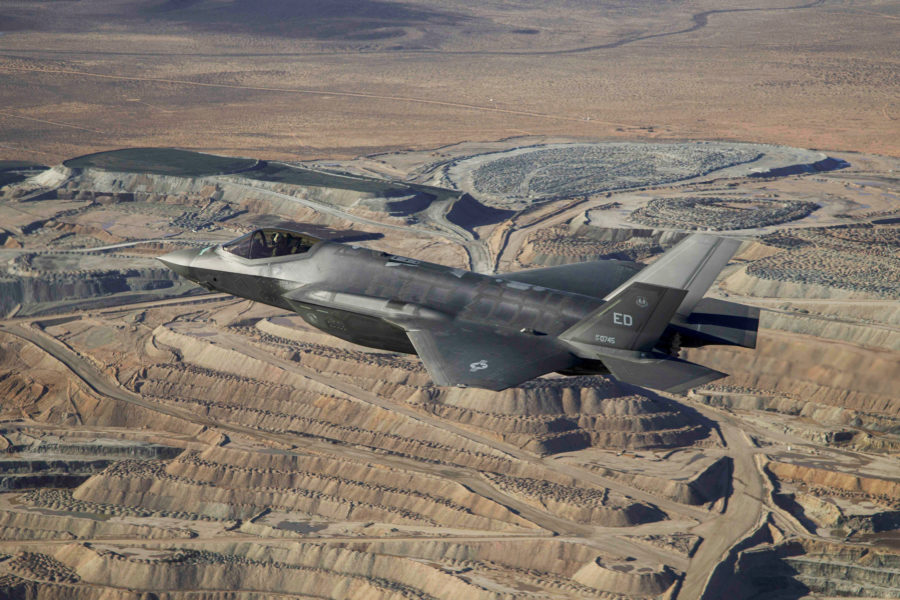The first F-35s with the Tech Refresh-3 upgrade—largely a processor upgrade upon which the Block 4 configuration of the fighter will ride—will be delivered before the middle of next year, a Lockheed Martin spokesperson said Sept. 6.
Previously, TR-3 jets were forecast to become available in the last quarter of calendar 2023.
In the meantime, the Air Force is prioritizing deliveries of jets with the TR-2 configuration to new F-35 units, according to Gen. Mark Kelly, head of Air Combat Command.
Aircraft that come off Lockheed’s assembly line with the TR-3 hardware will be stored until testing clears them for acceptance by the services—flight testing began in January and is still ongoing. But the last aircraft delivered to the Air Force with the TR-2 configuration are earmarked for new F-35 bases, like Tyndall Air Force Base, Fla., Kelly said.
“We have updated our F-35 TR-3 schedule projections with a first TR-3 aircraft delivery between April and June 2024,” the Lockheed spokesperson said.
“As a result, we now expect to deliver 97 aircraft in 2023, all in the TR-2 configuration. We are continuing aircraft production at a rate of 156 per year while simultaneously working to finalize TR-3 software development and testing. Additionally, we remain focused on receiving the necessary hardware from our suppliers to deliver this critical combat capability for the F-35.”
Kelly, speaking at the Defense News conference in Arlington, Va., said a team comprised of ACC officials and the office of the deputy chief of staff for operations have worked out “a rather elaborate plan” which will “not delay the initial arrival of airplanes” at new F-35 bases.
He noted that Tyndall “just got their first four airplanes; we didn’t want to delay that. I believe that Alabama and the other units that are slated to get F-35s will get them on time.” The priority for new bases is so they can start to become practiced at operating and maintaining the jets as soon as possible, to make easier the absorption of more new jets later.
However, delay in follow-on deliveries to the new operating locations “will take an impact” on the combat air forces, Kelly said, “depending on the amount of the delay.”
Kelly said the Air Force needs the TR-3 with all possible speed, because “the high-end software, high-end hardware, high-end EW (electronic warfare) is hard business.”
“But we stay in lockstep with our industry partners. And we need to lock arms and help them work through this as a team, but there will be impacts,” he added.
When a unit converts to new airplane, Kelly said, “usually by the time they get their last airplane, the clock starts, and they need to be ready to go [to war] a year or so later. Well, that will delay and that will impact” the Global Force Management system.
Units in the process of receiving new equipment won’t be back in rotation for forward deployments on time, and that will affect USAF’s readiness, Kelly said.
The Air Force has long said it prefers to buy the minimum number of F-35s possible until the Block 4 is ready, and Kelly emphasized the service will continue to operate as best it can until TR-3 is ready. However, the upgrades are key to the future fight, he said.
“The whole idea of a challenging peer scenario is a very challenging electromagnetic spectrum [fight] and very capable threats,” Kelly said. “And if we’re going to engage that spectrum or engage those threats, we’ve got to have the fastest processing, the best jamming, the most coherent waveforms available. And that takes a really, really agile, stable software load to unlock those Block 4 hardware” [capabilities] and unlock the EW. That’s kind of the secret sauce that we’re going to need.”
Lt. Gen. James C. Slife—just nominated to become the new Air Force vice chief—echoed Kelly’s comments and added that “I wish we had the ability, when a crisis pops up somewhere around the globe, to be able to evaluate it and say, ‘Does this crisis need a TR-3 Block 35 or is a TR-2 Block 35 sufficient?’”
Instead, the Air Force is flying on “the knife edge of capability” because it’s short of fighters, he said.
“It’s frankly … check your pockets, see what you have in your pocket. And that’s what goes. So getting these jets on time and fielded is absolutely critical to our ability to meet the global demand signal on a day to day basis,” Slife said.
The Lockheed spokesperson said the TR-3 “remains our No. 1 development priority. We are applying critical expertise to deliver TR-3, with more than 500 employees, 15 labs and flight test occurring at Edwards Air Force Base and Naval Air Station Patuxent River.”
The software testing schedule has been delayed, the spokesperson said, “due to unexpected challenges associated with hardware and software development, component and system integration testing and qualification testing.” The Integrated Core Processor, which is the heart of the TR-3, is being built by L3Harris.
“We have deployed employees to L3Harris to help expedite hardware delivery and are working diligently with Raytheon on their delivery of the Next-Gen Electro-Optical Digital Aperture System (EODAS), which will also be integrated with TR-3,” the spokesperson said.
